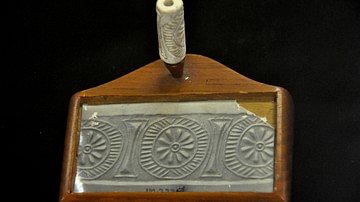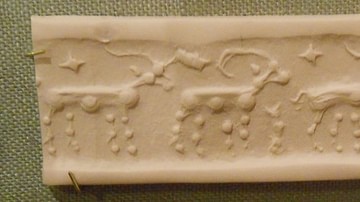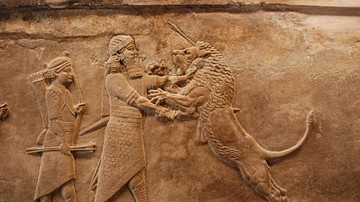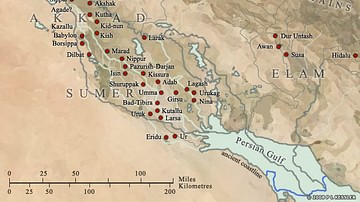Mesopotamian inventions include many items taken for granted today, most of which were created during the Early Dynastic Period (2900-2334 BCE) or developed from achievements of the Uruk Period (4100-2900 BCE). The Sumerians are credited with the earliest inventions, which were further developed in the Akkadian Period (2334-2218 BCE) and then by later Mesopotamian civilizations.
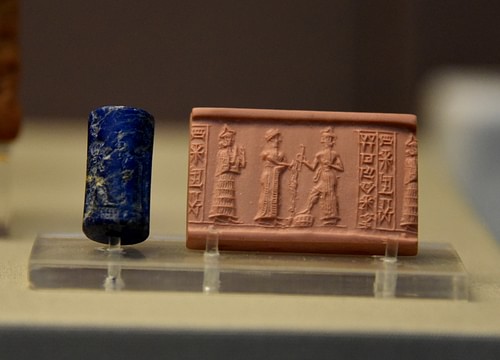
Among the many inventions of the Mesopotamians were:
- The wheel
- Mass-produced ceramics
- Mathematics
- Time
- Writing
- Cylinder seals and envelopes
- Mass-produced bricks
- Cities
- The map
- The sail
These ten represent only a small fraction of the technological, cultural, and scientific advancements pioneered in ancient Mesopotamia. Scholar Samuel Noah Kramer lists 39 'firsts' that appeared in ancient Sumer, were developed by later cultures, and are more or less familiar to people in the present day:
- The First Schools
- The First Case of 'Apple Polishing'
- The First Case of Juvenile Delinquency
- The First 'War of Nerves'
- The First Bicameral Congress
- The First Historian
- The First Case of Tax Reduction
- The First 'Moses'
- The First Legal Precedent
- The First Pharmacopoeia
- The First 'Farmer's Almanac'
- The First Experiment in Shade-Tree Gardening
- Man's First Cosmogony and Cosmology
- The First Moral Ideals
- The First 'Job'
- The First Proverbs and Sayings
- The First Animal Fables
- The First Literary Debates
- The First Biblical Parallels
- The First 'Noah'
- The First Tale of Resurrection
- The First 'St. George'
- The First Case of Literary Borrowing
- Man's First Heroic Age
- The First Love Song
- The First Library Catalogue
- Man's First Golden Age
- The First 'Sick' Society
- The First Liturgic Laments
- The First Messiahs
- The First Long-Distance Champion
- The First Literary Imagery
- The First Sex Symbolism
- The First Mater Dolorosa
- The First Lullaby
- The First Literary Portrait
- The First Elegies
- Labor's First Victory
- The First Aquarium (History Begins at Sumer, Contents)
These 39, developed between c. 5000-1750 BCE in Sumer, also do not fully represent all the inventions traced back to ancient Mesopotamia. The various cultures of the region borrowed from Sumer, and then each other, to develop some of the most impressive civilizations in history. Among the Mesopotamians’ most important inventions was writing, through the system they developed known as cuneiform, which has preserved the beliefs, history, and culture of the region that would significantly influence later civilizations in every respect. Scholar Paul Kriwaczek comments:
In the course of its two and a half millennia, the cuneiform-based tradition invented or discovered almost everything we associate with civilized life. Beginning in a world of Neolithic villages, largely self-sufficient and self-sustaining farming communities, and ending with a world, not only of cities, and empires, and technology, and science, and law, and literary wisdom, but even more: with what has been called a world system, a linked web of nations, communicating and trading and fighting with each other, spread across a large part of the globe. Such was the achievement of the writers of cuneiform. (11-12)
It is for this reason that Mesopotamia is referred to as the 'cradle of civilization', and a part of it as the Fertile Crescent, as it was in this region that many of the most important cultural developments were first established, flourished, and were shared with the rest of the world.
The Wheel
The wheel was invented c. 3500 BCE for the production of ceramics – the first potter’s wheel – and only later came to be used for transportation. Although the oldest wheel found thus far – the Ljubljana Marshes Wheel – comes from Central Europe, the concept of the wheel is believed to have originated in Mesopotamia earlier. By c. 3000 BCE, the Sumerians were using two-wheeled and four-wheeled carts and wagons to transport people and goods. According to scholar Stephen Bertman, "the wheels of these vehicles were made of two half-discs of solid wood nailed together and covered with tires of leather" (254). By c. 3200 BCE, the first chariots were made for the nobility and wealthy as forms of personal transportation, and these were later developed by the Akkadians and Assyrians for the military.
Mass-produced Ceramics
The potter’s wheel allowed for mass-produced ceramics, which provided the lower classes with affordable items such as jars and bowls. Previously, these items were handmade, and although anyone could – and did – fashion usable bowls and jugs from clay which was then sun-dried, they were inferior to those made by actual craftspeople. Mass-produced ceramics also supplied the military and labor force with containers for rations that could be easily carried and, if broken, quickly replaced. Craftspeople were usually attached to temples or palaces, which provided them with the raw materials for their art. Although produced en masse, these ceramics were often ornamented and decorated with painted figures, shapes, or designs.

Mathematics
The Sumerians developed mathematics at some point prior to their invention of writing. An understanding of mathematical principles and applications was a requirement for scribal training in the early Uruk Period and, by the Early Dynastic Period, geometry was used regularly in measuring out and dividing tracts of land as well as the creation of irrigation canals. Scholar Gwendolyn Leick explains, "this was done by measuring the sides of areas rather than angles, and fields with an irregular outline, for instance, were divided up into simple rectilinear parts, which were then added up" (116). Trigonometry never developed, as Leick notes, but the so-called Pythagorean Theorem was in use millennia before Pythagoras lived.
Time
At some point, after the invention of mathematics and usually dated to c. 3000 BCE, the Sumerians also created the concept of time. Using the sexagesimal system, they divided a day into 12 hours of light and 12 of darkness and then further divided these into 60-minute hours and 60-second minutes. Prior to this, it would appear, people worked from the time the day dawned until the sun set, but afterward, a limit of time could be placed on a workday and one’s day and night organized according to a system which was independent of sunrise or sunset. People could tell the time using sundials and water clocks, giving them greater control over their lives and a better means of organizing work, leisure, and religious observances.
Writing
Writing was invented around c. 3600 BCE, most likely in response to long-distance trade which required some means of communication between manufacturer, seller, buyer, and distributor. The writing system, as noted, was known as cuneiform, which developed from simple pictographs. These images could only relay the subject of a message, however, such as beer (the most popular drink in Mesopotamia and another Sumerian invention), but not whether the beer was coming or going from a given destination. Writing allowed people to specify their messages regarding quantity, quality, and whether an item was being bought, sold, or intended for sacrifice at the temple. The Alulu beer receipt from the city of Ur in 2050 BCE is among the best examples of the commercial aspect of writing as it acknowledges the delivery of a quantity of beer to the buyer from the brewer, Alulu. In time, as cuneiform became more sophisticated, it was used to record laws, recipes, prayers, hymns, stories, legends, and epics such as the tale of Gilgamesh. It also encouraged the development of different genres such as Mesopotamian Naru Literature, which served to both entertain and encourage important cultural values.

Cylinder Seals & Envelopes
Prior to the development of writing, people used small seals to authenticate agreements, created with a personal design signifying their identity and occupation, known as cylinder seals and stamp seals. The cylinder seal originated either in Sumer or the region now known as Syria c. 7600-6000 BCE. They were made from semiprecious stone (such as amethyst, lapis lazuli, marble, and obsidian, among others) and were worn around one’s neck, wrist, or attached to one’s clothing. The cylinder seal was pressed into damp clay, leaving an impression that served as one’s signature in legal proceedings or business agreements. After writing was invented, the cylinder seal or stamp seal was used to sign correspondence and legitimize contracts. Once long-distance correspondence became more commonplace, clay envelopes were invented to contain a message. The envelope would be stamped on the outside with one’s cylinder seal which was only to be cracked open by the intended recipient. Cylinder seals became so closely associated with their owners that their loss was comparable to identity theft in the present day, as anyone who found a seal could use it as they pleased.
Mass-produced Bricks
Mass-produced bricks were developed during the Uruk Period around c. 3100 BCE. Prior to this time, each brick was made by hand and then either fired in a kiln or sun-dried. Making bricks, especially for monumental structures such as ziggurats (another Mesopotamian invention), was extremely labor-intensive, and this encouraged the development of brick molds into which a single worker could pack clay to make ten bricks, or more, at a time instead of only one. The clay was tempered with sand, straw, or chaff for durability and then either sun-dried or fired. This process allowed for building projects to proceed much more quickly and so encouraged the further development and expansion of cities.
Cities
Cities also first began to appear in the region during the Uruk Period, with Uruk as the first walled urban center rising in 4500 BCE (giving the period its name). During the earlier Ubaid Period (c. 5000-4100 BCE), the people had already moved from the hunter-gatherer phase to permanent agrarian settlements and built homes and other buildings from sun-dried, handmade brick. During the Uruk Period, these villages became more densely populated, expanded, and became the world’s first cities. The rise of the cities created different definitions of the populace as city-dwellers identified themselves with their city whereas, formerly, they had associated themselves with a tribe. Those who lived outside of cities still maintained their tribal identities, further classifying people as urban or rural citizens. Since scribes usually lived in cities, they favored city-dwellers over those beyond the walls in their works, and so city life came to be associated with culture and civilization while farmers or shepherds were considered lower class and uncultivated.
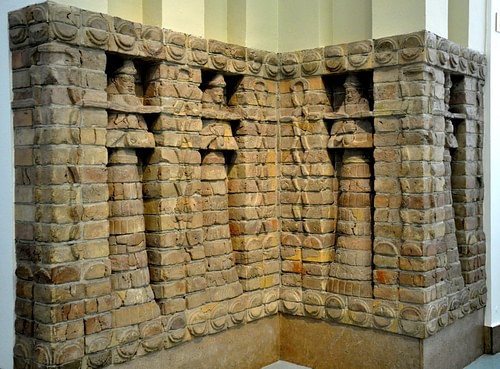
The Map
The growth of cities encouraged further long-distance trade, and so maps were created for caravans and single merchants and were eventually used for personal travel and military campaigns. Maps were made by carving images on various materials or by making impressions on a clay tablet. The oldest map in the world is the Imago Mundi, better known as the Babylonian Map of the World, created between 700-500 BCE, and found in the ruins of the city of Sippar. As each city considered itself the most important, first founded by their respective gods, and each map was made by someone in a given city, their respective city was given central position. In the Imago Mundi, Babylon is featured as the center of the world and other regions only in relation to it. Although the Imago Mundi is the oldest map extant, it is believed they were widely used much earlier than 700-500 BCE.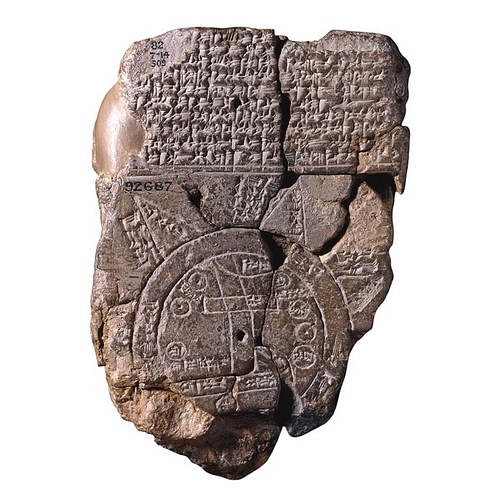
The Sail
The sail is thought to have developed through observation of the wind’s effects on a piece of cloth, most likely when it was hung out to dry after washing. Many merchants used the Tigris and Euphrates rivers in trade and had no difficulties rowing or poling their boats downstream, but coming back up was another matter. Rowers had to fight the current upstream in small reed-built boats which could fill and capsize as they struggled against the current. With the invention of the sail, a merchant could much more easily return to the point of origin and bring more goods along on the return trip than before. Sails were made of linen or papyrus and were rectangular or square in shape. Once the sail was mastered, long-distance maritime trade was possible with Egypt and the Indus Valley Civilization, bringing a greater variety of goods to Mesopotamia than ever before.
Conclusion
Such trade was made possible by the development of astronomy, which charted the stars and provided identifiable reference points in the night sky for travel. Astrology was developed in response to the age-old human desire to know the future and, in the case of trade, to receive word from the gods whether a business venture would end well or badly. The gods were understood as the source of all things, but one could never be sure of their intentions since one god might wish one only the best while another, feeling offended, might work against that god’s plans for one’s life. Divination was thought to provide some insight into what might be waiting for an individual on a given day.
The Mesopotamians were not a passive people, however, waiting on signs from the gods before acting to resolve a problem, conduct business, marriage arrangements, or remedy an illness or accident. The gods were consulted on all of these aspects of one’s life, but as humans were considered co-workers with the divine, it was understood that one had to act as best as one knew how and trust in the gods to assist in the venture. This was most clearly seen in the medical field where physicians would treat patients based on precedent as often as by appealing for divine assistance.
The various inventions of the Mesopotamians informed the different cultures of the region and allowed for the development of civilization for millennia. Mesopotamia was never a completely homogenous region, but the different city-states, kingdoms, and polities traded regularly, and innovations were regularly shared and spread further than their point of origin. The great political powers of Mesopotamia, such as the Akkadian and Assyrian empires, shared these inventions with others through long-distance trade, and this became more pronounced when the Persian Achaemenid Empire took the region and expanded to the borders of India.
The Achaemenid Empire fell to Alexander the Great in 330 BCE who expanded trade with the West, carrying more goods and technologies in that direction, and after his death, the Seleucid Empire continued these policies. In 226 CE, the Sassanian Empire absorbed the region, inheriting the achievements of the past and, in many cases, improving upon them before sharing them with others. In the present day, these innovations such as writing, time, the wheel, and mathematics are so integral to one’s daily life that their origin is rarely considered, but at one point, long ago, none of these existed until they were invented by the people of ancient Mesopotamia.
